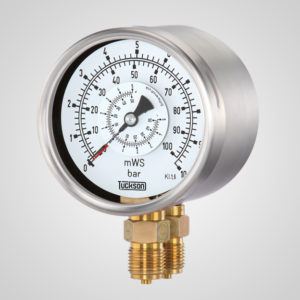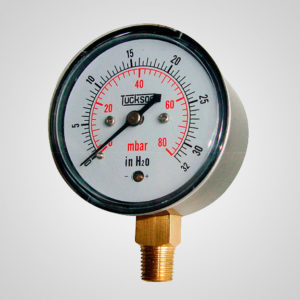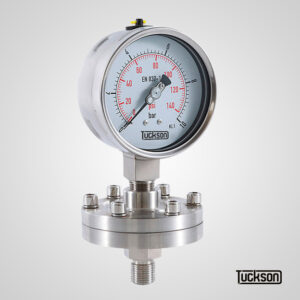Description
Ammonia Pressure Gauge
Applications
Ammonia pressure gauge is used to display pressure and temperature when measuring ammonia (NH3) refrigeration systems. This dual-scale dial gauge has an inner pressure scale with black numerals and an outer temperature scale with red numerals
Standard Features
Sizes
2.5″, 4″, 6″(63, 100 & 150 mm)
Accuracy
Dial 2.5”: 1.6% of full scale
Dial 4” & 6: 1% of full scale
Case material
304 Stainless Steel matte finished
Bayonet bezel
304 Stainless Steel
Window
Polycarbonate or safety glass
Bourdon tube / movement / socket
316 Stainless Steel
Operating Temperature
Ambient: -20 to 65°C (-4°F to 149°F)
Process fluid
max 65°C (149°F)
Dial
Aluminum with black & red markings
Pointer
Black aluminum
Dial 4” & 6: micrometer adjustable
Connection
1/4″, 1/2″ NPT or BSP, lower & back
Ranges
Vacuum to 150psi/F or 10Bar/C
Vacuum to 300psi/F or 21Bar/C
Working pressure
75% of full scale
Protection Degree
IP66
Liquid filling
Glycerin or dry but fill able execution
Installation tips
Pressure gauges mounted directly on piping should be assembled with reasonable care, always using the wrench grip provided on the pressure connection to secure it to the threaded fitting.
Do not use the gauge case as a means of tightening the connection.
In order to extend the service life and continued accuracy, the gauge should be protected as far as possible from effects of mechanical vibration. It is desirable to isolate it from severely vibrating machinery.
The gauge may be rigidly mounted to a non-vibrating surface and connected to the pressure source using flexible tubing.
Tip: we recommend the use of Needle Valves
Follow us on Pinterest





